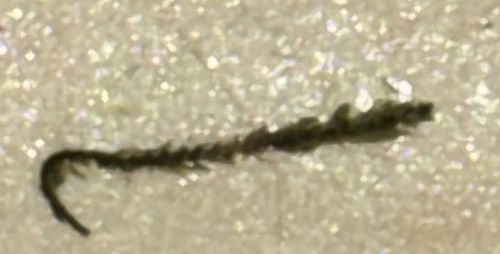Caddisfly larva (case-bearing)
Scientific Name: Too difficult to determine from the image alone without more specific morphological details, as it’s a larval stage and many species build similar cases.
Order & Family: Order: Trichoptera (Caddisflies), Family: Various (e.g., Limnephilidae, Leptoceridae, among others, depending on case construction and specific features)
Size: Typically 0.5 to 4 cm (0.2 to 1.6 inches) depending on the species and stage of development.

Natural Habitat
Found in various freshwater aquatic environments, including streams, rivers, lakes, and ponds, often in clean, well-oxygenated water. The image suggests a larva that camouflages itself with surrounding debris, typical of case-building species.
Diet & Feeding
Diet varies by species, but many are detritivores (feeding on decaying organic matter), herbivores (feeding on algae and aquatic plants), or sometimes predators (feeding on small aquatic invertebrates).
Behavior Patterns
Larvae weave silk cases and attach debris like sand, detritus, or plant fragments for camouflage and protection. They are primarily aquatic and often found clinging to submerged surfaces in flowing water. They pupate in their cases, and adults are short-lived, primarily focused on reproduction.
Risks & Benefits
Caddisfly larvae are excellent bioindicators of water quality, as many species are sensitive to pollution. They play a crucial role in aquatic food webs, breaking down organic matter and serving as prey for fish and other aquatic animals. They pose no direct risks to humans.
Identified on: 8/27/2025